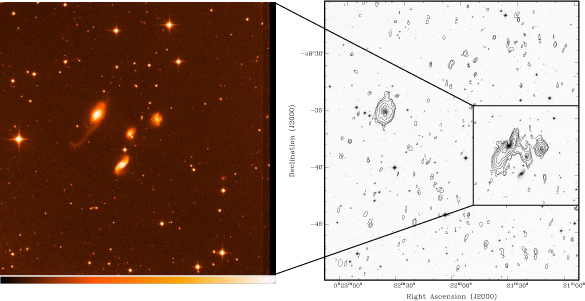Optical and radio survey of
Southern Compact Groups of galaxies
Summary
Compact groups of galaxies are outstanding laboratories for studies of the influence of gravitational interactions on the chemical and dynamical evolution of galaxies. Gravitational interactions are likely the most efficient way of removing gas from galaxies into intergalactic space, especially in dense, low velocity dispersion environments. The Southern Compact Groups (SCGs) sample is a complete sample of compact groups of galaxies described by Iovino (2002), based on objective, automated selection criteria, ideal for studies of the dynamical and chemical evolution of their member galaxies. The goals of our optical and radio survey are to assess how important galaxy interactions are in triggering star formation and Active Galactic Nucleus (AGN) activity and therefore the production of heavy elements and energy in galaxies and whether tidal disturbances then lead to the removal of chemically enriched matter from the interacting galaxies. In addition, this project serves as a test of whether elliptical galaxies are indeed, as envisaged in the hierarchical clustering scheme, the end products of major mergers of smaller, potentially gas-rich disk galaxies.
Optical survey
Based on automated search criteria, 121 candidate southern compact groups were identified on COSMOS digitised plates by Iovino (2002). Of these, a complete subsample of 50 SCGs were re-observed at optical and a small number at near-infrared (NIR) wavelengths with various telescopes of the European Southern Observatory (ESO).
Optical spectroscopy was employed to establish group membership of individual galaxies and thereby to validate the status of a candidate as a compact group based on the initial selection criteria. Spectra of the nuclear regions are used to obtain quantitative information on the type of nuclear activity (starburst vs. AGN) and, in the case of starbursts, to measure nuclear star formation rates.
Optical/NIR imaging was performed to obtain a database based on which model fits could be performed to morphologically decompose the galaxies into their various constituents and to search for deviations from regular shapes that might hint at the presence of external disturbances caused by interactions.
Compact Array HI and radio continuum observations
A second powerful tool for searches of signs of galaxy disturbances and/or interactions is HI line imaging. A search of the Compact Array online data archive revealed that six SCGs from the subsample of 50 had previously been observed in both the HI line and 1.34 GHz continuum emission, leading to a small pilot study.

Figure 1: Optical image (left) and HI total intensity contours on a DSS-2 red image (right) of SCG0018-4854. Both show signs of disturbance affecting the morphology of the dominant spiral, NGC 92. The group is classified by us as being in a late evolutionary phase (3b), following the scheme outlined by Verdes-Montenegro et al. (2001).
Total radio continuum flux densities, after exclusion of AGNs, are a measure of the total star formation rates in galaxies in these groups, which can be compared directly with their dynamical state. In line with previous results (e.g., Hummel et al. 1990), the nuclear regions of interacting galaxies are found to be on average more active than those in the field. The results of this pilot study of six SCGs have been summarised by Pompei, Dahlem, & Iovino (2007, A&A, submitted).
Other observations
For some objects, in particular SCGs dominated by early-type galaxies, but also for some dominated by spirals, X-ray observations were obtained with the XMM-Newton satellite to study the X-ray emission from member galaxies and to check for the presence of a hot intra-group medium.
On-going large project
The success of the initial Compact Array archival pilot study prompted the submission of a new, dedicated observing proposal. New Compact Array HI and radio continuum observations conducted by us form part of a multi-wavelength observing campaign aiming at addressing the points raised above based on a larger sample. A total of 16 objects have been observed with the Compact Array so far and work on the recently obtained datasets is underway.
References
Dahlem, M. 2005, A&A, 429, L5
Hummel, E., van der Hulst, J. M., Kennicutt, R. C., Keel, W. C. 1990, A&A, 236, 333
Iovino, A. 2002, AJ, 124, 2471
Pompei, E., Dahlem, M., Iovino, A. 2007, A&A, (submitted)
Verdes-Montenegro, L., Yun, M. S., Williams, B. A., et al. 2001, A&A, 377, 812
Michael Dahlem (ATNF Narrabri), Emanuela Pompei (ESO, Chile) and Angela Iovino (INAF - Osservatorio Astronomico di Brera, Italy)
(Michael.Dahlem@csiro.au)
